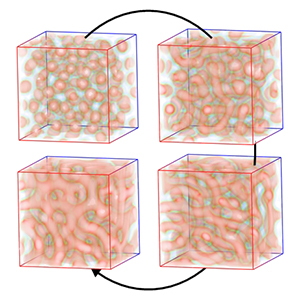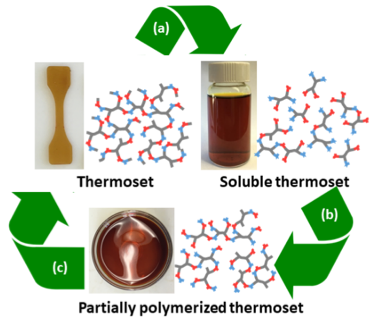

For collaborative research in polymer chemical engineering, our research groups use a combination of experimentation, theory, and simulation to understand the molecular behavior and structural origins of polymers, methods to develop synthetic polymers, and the behavior of polymeric liquids.
Bio-Inspired Synthetic Polymers
The Israelachvili group characterizes the adhesive and cohesive forces of molecules responsible for high performance polymer adhesion, and how they depend on the physicochemical environment they are subjected to. Fredrickson, Han and Helgeson use both experiment and theory/simulation to understand the formation of polymer gels and complex coacervates with biomimetic hierarchical structure, and how these structures modify the surface properties and mechanics of the resulting materials. The Segalman group designs and synthesizes biomimetic peptoid structures to understand the role of specific chemical sequences in marine biofouling. Polypeptoids are also leveraged for fundamental studies of the role tailored sequence plays in the resulting hierarchical polymer structure.
Self-Assembling Polymers
Segalman, Helgeson and Fredrickson are exploring the self-assembly characteristics and ion transport properties of polymerized ionic liquids. Segalman combines synthesis, dielectric spectroscopy and NMR diffusion studies to to track the motion and interactions of ions within the polymer medium. Helgeson and Segalman study the phase behavior, processing and dynamics of these materials using microcopy, rheology, x-ray and neutron scattering. Fredrickson works on theory and simulations to predict the development of morphology in these ion conducting materials.
Rheology and Polymeric Liquids
Leal and Helgeson carry out rheological studies to understand the flow properties of polymeric liquids to aid the design and optimization of their processing. Current studies focus on both the role of polymer chain architecture (i.e. flexibility, branching, or ring structures), as well as deformation type (shear, elongation and mixtures thereof). In collaboration, Leal and Fredrickson develop theories to describe the complex behaviors, including shear banding and strain localization, that can emerge in these systems, including a framework that considers the effects of stress-concentration coupling to produce non-homogeneous flows. Helgeson is performing in situ scattering measurements to rigorously test these theories.
Renewable and Remoldable Polymers
The Abu-Omar group synthesized and characterizes new materials derived from lignin and its molecules. Our group develops new synthetic methodology for making thermosets and Covalently Adaptable Networks (CANs) based on lignin-derived triphenol motifs. We use dynamic mechanical analysis (DMA) and rheology to characterize these materials and compare them to their petroleum-derived counterparts. Recent advances in the group include the creation of remoldable and self-repairing renewable thermosets



